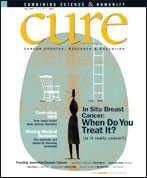Publication
Article
CURE
Watch It or Treat It?
Author(s):
Many experts consider lobular carcinoma in situ, LCIS, to be a precursor to invasive breast cancer, but there is still debate over the best treatment including surgery and prevention with tamoxifen or Evista.
Although LCIS shares the phrase “carcinoma in situ” with DCIS, these cells are usually not as severely abnormal as those classified as DCIS. Some experts think it should be renamed to more clearly indicate that these abnormal cells are benign.
A diagnosis of LCIS does mean, though, that a woman has a higher risk of getting invasive breast cancer later in life, and some experts now consider LCIS to be a true precursor to invasive cancer. An analysis of existing data published earlier this year in Cancer found that LCIS may signal the early stages of invasive disease.
Because of the multifocal nature of LCIS, the cancer could be in either breast, although it is slightly more likely to occur in the same breast as the LCIS. The number of LCIS cases has more than doubled since 1980, and because it rarely has any symptoms and there is no test to discover it, LCIS is almost always discovered incidentally during a biopsy of another lesion. A pathology second opinion may be appropriate since LCIS can be a difficult condition to diagnose.
Previous wisdom called for surgical removal of the affected breast, but it is now known that the presence of LCIS in one breast increases the risk of cancer in both breasts. Although the current recommendation for most women with LCIS is to watch and wait, some researchers think bilateral mastectomy should be discussed with women who have LCIS and a family history of breast cancer in a parent, child or sibling. Other doctors say this is an overly aggressive approach.
Treatment with tamoxifen is a non-surgical option for decreasing the risk of invasive breast cancer after LCIS. In the Breast Cancer Prevention P-1 trial, which involved 13,388 women with LCIS considered at high risk of invasive cancer, tamoxifen decreased the risk of invasive breast cancer by half. The STAR trial, which compared tamoxifen with the osteoporosis drug Evista, found that while Evista may be a good option for women at high risk of invasive breast cancer, the drug did not lower the risk of noninvasive breast cancer, including LCIS. Both Evista and tamoxifen carry side effects, such as blood clots and heart problems, so patients must consider both the benefits as well as the risks of these preventive agents.






